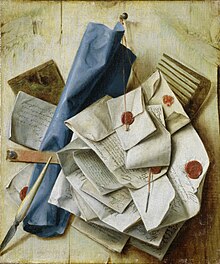Sealing wax

Sealing wax is a resinous mass that solidifies after heating (over a candle / spirit lamp or as a sealing wax stick with a wick, also with a melting spoon or a glue gun / automatic sealing machine ) and draining. It is used to ( seal ) letters and packages. Rarely also for covering the corked bottle mouth. Usually a moistened metal stamp or a seal or a seal ring is pressed into the still soft paint. The individual imprint should not only guarantee the integrity of the content but also its authenticity. In modern automatic letter sorting systems, however , the use of lacquer seals on envelopes can lead to malfunctions.
Sealing wax can also be used to fasten leather upholstery on the flaps of clarinets.
The Portuguese brought the sealing wax from the East Indies to Europe ; it was therefore previously called "Spanish wax".
Sealing wax consists of shellac and turpentine , often with the addition of benzoin , tolu balsam and storax resin or simply turpentine and rosin . Additions of chalk and zinc white prevent it from dripping off too quickly. A cheap form of sealing wax is the so-called packing varnish . Packaging varnishes do not contain shellac, but rather turpentine resin and rosin. Only inferior material, often brick dust, is used to color them red.
application
Sealing wax is available in three different forms that are heated differently:
- Pure sealing wax sticks. They are slowly heated over a flame while constantly turning until enough varnish is hot or soft, then heated briefly more to liquefy it completely, and then wiped off on the paper just before the drop. Traces of soot can be avoided with alcohol flames.
- Sealing wax sticks with wick: Here the wick is lit like a candle and the liquid sealing wax is dripped onto the paper until a sufficiently large amount is on the paper.
- Sealing wax granulate is melted in a melting spoon over the flame and then poured onto the paper. To seal bottles, the corked mouth is briefly dipped a few centimeters into molten sealing wax that has been liquefied in a heat-resistant container.
Recipe
For example, the following recipe was recommended in 1949 for the production of "finest" red sealing wax:
- Shellac 35%
- Cinnabar 26%
- Larch turpentine 24%
- Magnesium oxide 6%
- Turpentine oil 9%.
Different colors are generally obtained by adding mineral pigments . Older recipes often include the use of pigments based on lead , mercury or other heavy metals . Typical coloring substances are for example:
- red: vermilion, red lead , red iron oxide
- green: verdigris , zinc green
- yellow: chrome yellow , new yellow
- gold: bronze powder and "gold foam" (leaf tombac )
- blue: ultramarine
- black: soot , burnt ivory .
Demarcation
A lacquer in mechanical engineering that is applied to screws is also known as sealing wax. Unscrewing the screw breaks the paint and the manipulation can be seen afterwards.
conditions
It is required of good sealing wax that seals produced with it reproduce the image of the seal clearly and clearly and that manipulation or removal of the seal is not possible without leaving traces.
Trivia
In the broadest sense, sealing wax is one of the hot-melt adhesives , since in addition to its function as a "safety lock", the adhesive effect is used for closures.
literature
- Jens Dannehl: Damaged seals and their conservation and restoration. Using the example of the documents of a spiritual Westphalian chapter from the North Rhine-Westphalian State Archives in Münster . Cologne 1993.


